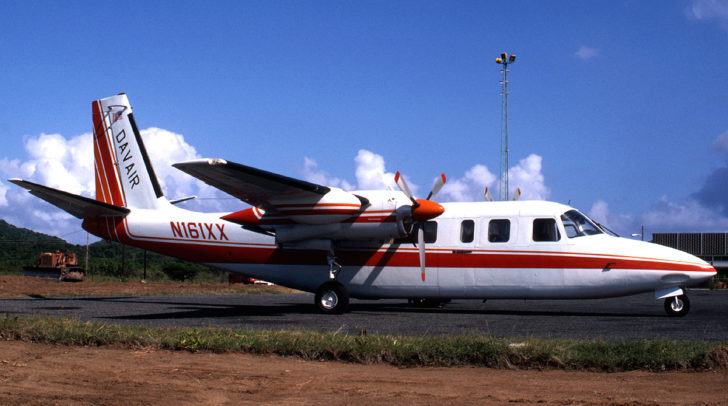By Barry Collman

Certificated as N4557E on August 18, 1967, this 680V had the Miller nose and picture windows installed 10 days later. The N-number was changed to N299F for the International Crystal Manufacturing Co, Inc., of Oklahoma City, and was sold to them by Downtown Airpark, on October 9, 1967. After further N-number changes—to N299FL, N161X and N161XX—it was sold to Davoil Inc., of Fort Worth. The Javelin 50-gallon slipper tanks, seen here in the photo, were installed on March 17, 1980. The image was taken in the 1980s at Beef Island in the British Virgin Islands by Austin J. Brown. In July 1992 it was exported to Brazil for a “sales demo,” but no trace of it is known after that.
The Model 680V was the seventeenth Commander model to be placed into production, the first two by the Aero Commander Division of Rockwell-Standard Corporation at Bethany (Wiley Post Airport) near Oklahoma City, Oklahoma, and the last 24 by the Aero Commander-Bethany Division of Rockwell-Standard Corporation.
The 26 examples were built between June 1967 and January 1968, with serial numbers in the range 1609-45 through 1720-91.
Of these, 22 were initially certified in 1967 and four in 1968.
Later, 51 Models 680Vs were converted from Model 680Ts.
The Models 680T and 680V share a common unit-number sequence, hence the first 680V was serial number 1609-45, with only 26 built.
A factory document describes the Model 680V, under Wing Drawing 5170045 with removed 32-inch wing-tip extension, as “certified on June 13, 1967, to the same certification basis as the 680T. The primary difference between the 680V and the 680T is the increased gross weight to 9400 pounds. The 680T with the following configuration changes define the 680V: a) structural requirements due to gross weight increase; b) contoured radome nose; c) fuel-flow system with totalizer; d) picture windows; e) clam shell landing gear doors; f) fuel vent heaters; and g) improved soundproofing. Loads and stress substantiation reports refer to this model as the 9400 pounds 680T.”

Scanned from a color slide taken by Mike Hooks at London’s Heathrow Airport in July 1968, N228W is in factory paint design #TC-D-1 in Insignia White, Electric Blue and Laguna Blue. At the time, it was registered to Intercontinental Air-Lease Corp. of Columbus, Ohio, having been bought from Western Commander Inc., of Santa Monica. In December 1972 the registration was cancelled because of export to Belgium, where it was registered as OO-SKF, with Societe des Transports Aeriens, Maritimes et Terrestres NV (Sotramat) of Brussels listed as the owner of record. It was damaged in December 1978 and became N8042N, with Business Aircraft Corp., of Atlanta, Georgia. A ferry permit for a flight from Biggin Hill, U.K. to Fort Lauderdale, Florida, was issued on February 19, 1980. Eventually the fuselage was acquired by Downtown Airpark and was used to test various aerial survey camera installations.
Type Certificate Data Sheet Note 9 says “The Model 680T is eligible as a Model 680V when modified in accordance with Aero Commander Dwg. 6100034,” whereas the correct Drawing No. is 6100031.
The Model 680V was indeed certified on June 13, 1967, under Type Certificate 2A4. The first 25 examples were fitted with AiResearch TPE331-43 engines, with the last one originally having TPE331-43As. The 90-inch-diameter Hamilton Standard 33LF-325/1033A-0 propeller was used on all 680Vs.
Gross weight of the 680V is 9,400 pounds, and the cabin pressure differential is 4.2 psi, giving a 13,000-foot cabin at 27,955-foot altitude and a sea-level cabin at 9,025 feet.
Some examples have been modified to a so-called “Century Turbo” with the TPE331-43 series engines being replaced by the TPE331-1-151K.
The 680V wasn’t built with the cockpit overhead or “eyebrow” windows, but at least two have had these installed under Factory Drawing 5360014.
Barry Collman’s lifelong interest in airplanes began when he was growing up in a house located underneath the downwind leg to busy Northolt aerodrome, an R.A.F. base near London-Heathrow airport. As a young teenager he discovered airplane “spotting”–hobbyists’ observation and logging of aircraft by make, model, and registration number. The hobby began to grow into a passion as Collman joined a club of like-minded spotters. At one point he purchased a copy of the January 1966 U.S. Civil Aircraft Register, and thumbing through it came upon the Aero Commander. He was hooked. Eventually he acquired every available FAA microfiche file on Commanders, and since 1995 has made annual pilgrimages to Oklahoma City to sift through FAA records. He now has a database with about 100,000 records as well as a collection of negatives, slides, photographs, digital images, magazines, brochures, knick-knacks–and a very understanding wife. This series on Commander production history originally was written for the Twin Commander Flight Group, of which he is an enthusiastic member.
